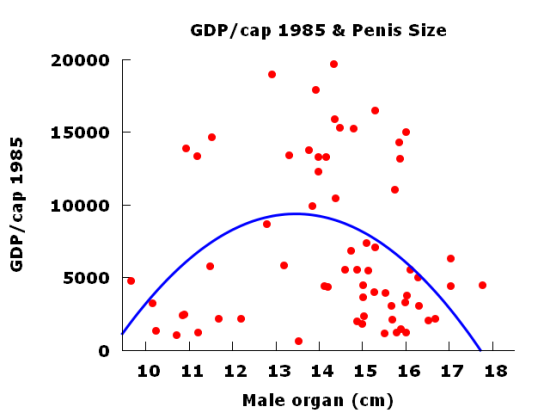Economic growth and the size of the ‘private sector’ Economic growth has since long interested economists. Not least, the question of which factors are behind high growth rates has been in focus. The factors usually pointed at are mainly economic, social and political variables. In an interesting study from the University of Helsinki, Tatu Westling expanded the potential causal variables to also include biological and sexual variables. In the report Male Organ and Economic Growth: Does Size Matter (2011), he was — based on the ‘cross-country’ data of Mankiw et al (1992), Summers and Heston (1988), Polity IV Project data of political regime types and a data set on average penis size in 76 non-oil producing countries (www.everyoneweb.com/worldpenissize) —
Topics:
Lars Pålsson Syll considers the following as important: Statistics & Econometrics
This could be interesting, too:
Lars Pålsson Syll writes Keynes’ critique of econometrics is still valid
Lars Pålsson Syll writes The history of random walks
Lars Pålsson Syll writes The history of econometrics
Lars Pålsson Syll writes What statistics teachers get wrong!
Economic growth and the size of the ‘private sector’
Economic growth has since long interested economists. Not least, the question of which factors are behind high growth rates has been in focus. The factors usually pointed at are mainly economic, social and political variables. In an interesting study from the University of Helsinki, Tatu Westling expanded the potential causal variables to also include biological and sexual variables. In the report Male Organ and Economic Growth: Does Size Matter (2011), he was — based on the ‘cross-country’ data of Mankiw et al (1992), Summers and Heston (1988), Polity IV Project data of political regime types and a data set on average penis size in 76 non-oil producing countries (www.everyoneweb.com/worldpenissize) — able to show that the level and growth of GDP per capita between 1960 and 1985 varies with penis size. Replicating Westling’s study — yours truly has used his favourite program Gretl — we obtain the following two charts:
The Solow-based model estimates show that the maximum GDP is achieved with the penis of about 13.5 cm and that the male reproductive organ (OLS without control variables) are negatively correlated with — and able to ‘explain’ 20% of the variation in — GDP growth.
Even with the reservation for problems such as endogeneity and confounders one can not but agree with Westling’s final assessment that “the ‘male organ hypothesis’ is worth pursuing in future research” and that it “clearly seems that the ‘private sector’ deserves more credit for economic development than is typically acknowledged.” Or? …


